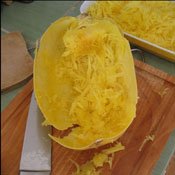One of the easiest comfort foods to serve is steaming hot, baked spaghetti squash.
Available year-round, spaghetti squash, with its deep gold fruit, provides folic acid, potassium, vitamin A and beta-carotene. It averages only 42 calories per 1-cup serving.
Bright rays of sunshine burst out of a cooked spaghetti squash. The long, intensely yellow strands of squash are easier to prepare than pasta. Tossing a football-sized squash in the oven is about as complicated as it gets. Most people will be proper and slice a spaghetti squash in half, clean out the seeds, then place it on a pan and cook it at 400 degrees for 45 minutes.
If you remove the seeds, don't throw them away. Roast seeds the same way as pumpkin seeds: Spread lightly buttered seeds on a baking sheet and roast in a 300-degree oven for 45 minutes.
Spaghetti squash substitutes for noodles in many dishes. It doesn't taste like pasta, but it makes a fun, interesting alternative to a tired routine. Use your favorite pasta sauce, meatballs and garlic bread. Fork strings of golden goodness into a bowl and toss with a little olive oil and basil and perhaps some Parmesan cheese. Or eat it just as it is, subtly sweet and slightly crunchy.
Squash doesn't really need a lot of covering up. For example, a really good butternut squash already tastes buttery and sweet, so sweet it can take you back to childhood.
Acorn squash is another simple comfort food—cut it half, bake and serve in its own bowl. Clean up is easy and organic.
Besides being so darn easy and healthy, squash is a native Mississippi food. It's been a staple of southern diets as long as beans, corn and tomatoes. It's also affordable. You can get a lot of squash for just $1. And while many cookbooks refer to this vegetable as a side dish, consider making it the main dish.
If you can't eat it all, don't worry: Squash freezes well and will wait to comfort you again.



Comments
Use the comment form below to begin a discussion about this content.
comments powered by Disqus